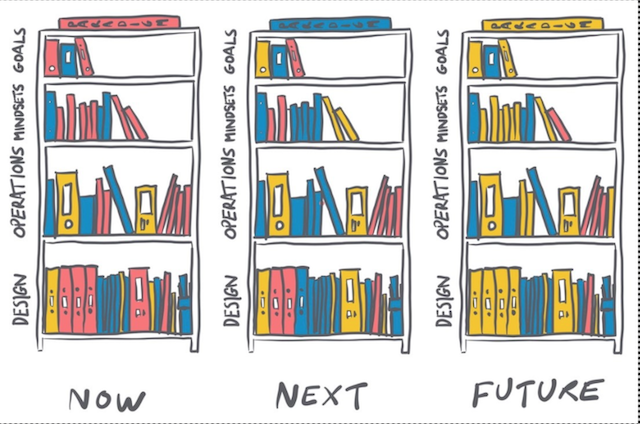The Library of Systems Change helps us understand how we can make systemic change over time. It combines the future thinking of Bill Sharpe’s Three Horizons Model with the systems organisation of the Systems Bookcase. It is another model James Norman and I developed in ‘the Regenerative Structural Engineer’, but which can apply to any system in engineering. The overall effect is a compelling visual model for how a system might change over time.
What’s in the Library of Systems Change?
The Library of Systems Change has three bookcases, labelled ‘now’, ‘next’ and ‘future’. We organise the shelves on the bookcases in the same way as for the simple Systems Bookcase. Design at the bottom, then operations, mindsets, goals and right at the top, paradigm.

The Library of Systems Change, as proposed by Broadbent and Norman in the Regenerative Structural Engineer.
The colour of the books correspond to the three horizons in Bill Sharpe’s model. The red books are for Horizon 1 (H1). These represent the current, dominant patterns of working. The yellow books are for Horizon 3 (H3). Yellow books represent the future, more viable patterns of work that we want to create. The blue books are for Horizon 2 (H2), the transition that enables us to step from our current patterns of work to future, more viable patterns of work.
The bookcase of the present
The left-hand bookcase in the Library of Systems Change represents the world as we see it now. We call it the bookcase of the present. Red books dominate the the shelves, representing the dominant patterns of organising industry in the present.
The yellow books represent rare examples of the future patterns that we envision that already exist in small way in the present. They are few and far between because they contradict the dominant, H1 paradigm of the present.
The blue books represent those transition patterns, which will ultimately create the stepping stone to the future we want to build. There are more of these because while they still challenge the dominant paradigm they are still just about tolerable.
Thinking about the world that you see around you:
- What are the H1 patterns that you think represent a system in decline? If they were red books, on which shelf in the bookcase of the present would you put them?
- Can you see examples of a thriving world that already exist? If these were yellow books, where would you file them on the bookcase of the present?
- And what about the transitional patterns. Can you see any patterns that exist in the present that represent a transition to a more viable world? If these were blue books, what would they be called and on which shelf in the bookcase of the present would file them?
The bookcase of future
The right-hand bookcase in the Library of Systems Change represents the viable, thriving world that we want to create. We call this the bookcase of the future. Here, yellow books dominate, representing patterns that are consistent with this world we want to create. There are still some blue books in place from the transition. And there are a handful of red books. These red books represent practices from the present that by necessity persist or are valued in the future.
The challenge of the bookcase of the future is that it is very hard to see what is on it. The view is obscured by horizon 1 and horizon 2.
As Daniel Wahl describes, the best guide we have to the future is to ask questions about it. Bill Sharpe once said to me that the best guide to the future is our deeply held values.
In the Regenerative Design Lab, we use the living world itself as a guide to what regenerative design might look like. We capture this thinking in a pattern we call the Living Systems Blueprint.
Thinking about this bookcase of the future:
- What guides you when trying to imagine a more viable future?
- What challenges you in trying to imagine this future?
- What elements of the present will still be there in the future?
The transition bookcase
Finally, the middle bookcase in the Library of Systems Change represents the transition from present to future. It is the space in which a transition paradigm emerges. Something which is not quite the future we imagine but an evolution away from the present and towards that more viable future.
This is a time of crossover. The H1 patterns of the present are in decline, the H3 patterns of the future are rising, and the H2 patterns of transition hold everything together.
The regenerative designer operates in this transition space, and has three roles:
- growing the transition patterns – adding to the blue books – that create fertile ground for the future patterns to emerge
- planting and tending to future patterns so that they can seed – writing the yellow books
- actively dismantling destructive patterns from the present – taking the red books off the shelf
Thinking about the transition bookcase:
- What blue books do you see people engaged in change writing or contributing to around you?
- Who is writing the yellow books can how can you support them?
- How can we carefully but assertively start removing the red books to create the transition?
Conclusion on the Library of Systems Change
The Library of Systems Change helps to hold the present, the future and the transition to that future in mind. It shows us that lots of different sorts of work are needed to create the transition to a viable future. Some of that work is of imagination. There’s work of creating stepping stones of transition, and there’s work to actively manage out there present.


One Reply to “The Library of Systems Change”
Comments are closed.